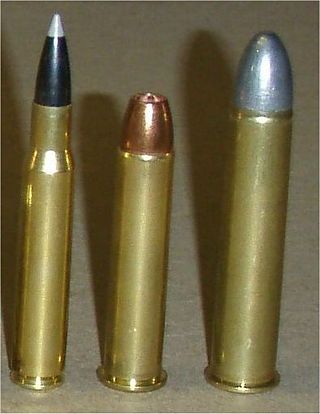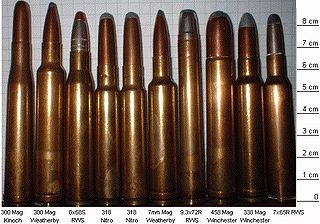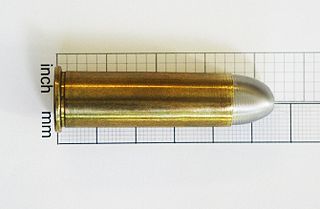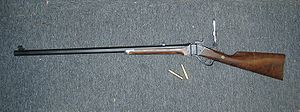A rifle is a long-barreled firearm designed for accurate shooting, with a barrel that has a helical pattern of grooves (rifling) cut into the bore wall. In keeping with their focus on accuracy, rifles are typically designed to be held with both hands and braced firmly against the shooter's shoulder via a buttstock for stability during shooting. Rifles are used extensively in warfare, law enforcement, hunting, shooting sports, and crime.

In firearm designs, the term single-shot refers to guns that can hold only a single round of ammunition inside and thus must be reloaded manually after every shot. Compared to multi-shot repeating firearms ("repeaters"), single-shot designs have no moving parts other than the trigger, hammer/firing pin or frizzen, and therefore do not need a sizable receiver behind the barrel to accommodate a moving action, making them far less complex and more robust than revolvers or magazine/belt-fed firearms, but also with much slower rates of fire.

The .50 Browning Machine Gun is a .50 in (12.7 mm) caliber cartridge developed for the M2 Browning heavy machine gun in the late 1910s, entering official service in 1921. Under STANAG 4383, it is a standard service cartridge for NATO forces as well as many non-NATO countries. The cartridge itself has been made in many variants: multiple generations of regular ball, tracer, armor-piercing (AP), incendiary, and saboted sub-caliber rounds. The rounds intended for machine guns are made into a continuous belt using metallic links.
Winchester rifle is a comprehensive term describing a series of lever action repeating rifles manufactured by the Winchester Repeating Arms Company. Developed from the 1860 Henry rifle, Winchester rifles were among the earliest repeaters. The Model 1873 was particularly successful, being marketed by the manufacturer as "The Gun That Won the West".

The .460 Weatherby Magnum is a belted, bottlenecked rifle cartridge, developed by Roy Weatherby in 1957. The cartridge is based on the .378 Weatherby Magnum necked up to accept the .458-inch (11.6 mm) bullet. The original .378 Weatherby Magnum parent case was inspired by the .416 Rigby. The .460 Weatherby Magnum was designed as an African dangerous game rifle cartridge for the hunting of heavy, thick skinned dangerous game.
The Spencer repeating rifles and carbines were 19th-century American lever-action firearms invented by Christopher Spencer. The Spencer was the world's first military metallic-cartridge repeating rifle, and over 200,000 examples were manufactured in the United States by the Spencer Repeating Rifle Co. and Burnside Rifle Co. between 1860 and 1869. The Spencer repeating rifle was adopted by the Union Army, especially by the cavalry, during the American Civil War but did not replace the standard issue muzzle-loading rifled muskets in use at the time. Among the early users was George Armstrong Custer. The Spencer carbine was a shorter and lighter version designed for the cavalry.

The .45-70, also known as the .45-70 Government and the .45-70 Springfield, is a .45 caliber rifle cartridge originally holding 70 grains of black powder that was developed at the U.S. Army's Springfield Armory for use in the Springfield Model 1873. It was a replacement for the stop-gap .50-70 Government cartridge, which had been adopted in 1866, one year after the end of the American Civil War, and is known by collectors as the "Trapdoor Springfield".

Sharps rifles are a series of large-bore, single-shot, falling-block, breech-loading rifles, beginning with a design by Christian Sharps in 1848 and ceasing production in 1881. They were renowned for long-range accuracy. By 1874 the rifle was available in a variety of calibers, and it was one of the few designs to be successfully adapted to metallic cartridge use. The Sharps rifles became icons of the American Old West with their appearances in many Western-genre films and books. Perhaps as a result, several rifle companies offer reproductions of the Sharps rifle.

The .458 Winchester Magnum is a belted, straight-taper cased, Big Five game rifle cartridge. It was introduced commercially in 1956 by Winchester and first chambered in the Winchester Model 70 African rifle. It was designed to compete against the .450 Nitro Express and the .470 Nitro Express cartridges used in big bore British double rifles. The .458 Winchester Magnum remains one of the most popular large game cartridges, and most major ammunition manufacturers offer a selection of .458 ammunition.

Remington Rolling Block is a family of breech-loading rifles that was produced from the mid-1860s into the early 20th century by E. Remington and Sons. The action was extremely strong, and could easily withstand the increased pressure of the new smokeless powders coming into use by the late 1880s.
The Marlin Model 336 is a lever-action rifle and carbine made by Marlin Firearms. Since its introduction in 1948, it has been offered in a number of different calibers and barrel lengths, but is commonly chambered in .30-30 Winchester or .35 Remington, using a 20- or 24-inch barrel. Currently, the model with a 24-inch barrel is only available in .30-30 Winchester. The Model 336 is now back in production as of March 27, 2023.

The Sharps-Borchardt Model 1878 is a single-shot hammerless falling-block action rifle designed by Hugo Borchardt and made by the Sharps Rifle Manufacturing Company. It closely resembles older Sharps Rifles but has a firing mechanism that uses a hammerless striker rather than a hammer and firing pin like the old Sharps Rifle. This hammerless dropping-block breech-loader was based on a patent granted to Hugo Borchardt in 1877. It was the last of the Sharps single-shot rifles, and the Borchardt did not sell very well. According to company records 22,500 rifles were made in all models from 1877 until the Sharps Rifle Co. closed down in 1881. Although it was designed for the huge black powder "buffalo" cartridges of the day, it came too late, at the very end of the great bison slaughter.

The Hawken rifle is a muzzle-loading rifle that was widely used on the prairies and in the Rocky Mountains of the United States during the early frontier days. Developed in the 1820s, it became synonymous with the "plains rifle", the buffalo gun, and the fur trapper's gun. It was displaced after the Civil War by breechloaders and lever-action rifles.

William Dixon was an American scout and bison hunter active in the Texas Panhandle. He helped found Adobe Walls, fired a buffalo rifle shot at the Second Battle of Adobe Walls, and for his actions at the "Buffalo Wallow Fight" became one of eight civilians ever to receive the U.S. Medal of Honor.

The .50-70 Government, also known as the .50-70 Musket and the .50-70 Springfield) is a black powder cartridge adopted in 1866 for the Springfield Model 1866 trapdoor rifle.

The .50-90 Sharps rifle cartridge is a black-powder cartridge that was introduced by Sharps Rifle Manufacturing Company in 1872 as a buffalo hunting round. Like other large black-powder rounds, it incorporates a heavy bullet and a large powder volume, leading to high muzzle energies.
The .45-90 Sharps cartridge is a black powder round introduced in 1877 by the Sharps Rifle Manufacturing Company. Also known as the .45 2 4/10, the cartridge was developed for hunting and long range target shooting. In the modern day, it is used for Black Powder Cartridge Rifle competitions.

The .50-140 Sharps rifle cartridge is a black-powder cartridge that was introduced in 1884 as a big game hunting round. It is believed to have been introduced for the Sharps-Borchardt Model 1878 rifle. The cartridge is very similar to the .500 Black Powder Express.

The .458 Lott is a .458 caliber rifle cartridge designed for the purpose of hunting large, thick-skinned dangerous game animals in Africa. It is based on the full length .375 H&H Magnum case blown out and shortened to 2.800 inches (71.1 mm).

Varmint rifle is an English term for a small-caliber precision firearm or high-powered airgun primarily used for both varmint hunting and pest control. These tasks include killing three types of pests or nuisance animals that spread diseases or destroy crops or livestock:















